Marc Leepson's Blog, page 2
November 12, 2024
November 2024
VolumeXXI, Number 11 November2024

BOUNTEOUS HOSPITALITY: By the early 1890s, as I wrote in Saving Monticello,Jefferson Monroe Levy, a self-made millionaire real estate and stockspeculator, was enjoying a lavish lifestyle. The owner of Thomas Jefferson’sMonticello since 1879, he also had an opulent townhouse in New York City, owned a good number of commercial properties in Manhattan and in and around Charlottesville, and regularly traveled to England, France, and Italy. I’ve likened the life-long bachelor to being a late 19th century equivalent of a mid-twentieth century jetsetter, as he regularly hobnobbed on the Continent with royalty and others in his exalted income bracket.[image error][image error]
Between his globetrotting, J. M. Levy spent many summerweekends and most Thanksgivings at Monticello, oftentimes in the company ofmembers of his family. A staff of domestic servants catered to their needs onthe mountaintop. Some worked year-round at Monticello; others were Levy’s NewYork employees, including his valet, butler, and laundress. His sisterAmelia Mayhoff took over as Jefferson Levy’s Monticello co-hostfollowing their mother’s death in January 1893.
During the 40-plus years Jefferson Levy (below) ownedMonticello, he also hosted countless out-of-town visitors Many of them werenationally prominent political figures, mostly Democratic Party higher-ups. Thelong list included members of Congress, governors and two sittingpresidents—Grover Cleveland and Theodore Roosevelt.
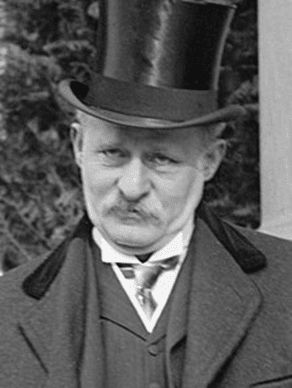
A fiscally conservative Democrat, Jefferson Levy begantaking an active interest in politics in the last decade of the 19thcentury. He had become an influential voice in the Virginia Democratic Partyand made strong connections with party leaders in New York. That networking culminatedin him being the Democrats’ nominee to represent New York City’s thirteenth congressional district in a special election in 1899, which he won. Levy servedfor two years in the House, and did not choose to run for re-election in 1900.But ten years later, he re-launched his political career and served two moreterms in Congress, from 1911-15, before deciding not to run again in 1914, afterthe U.S. entered World War I.
One reason Levy bowed out of politics in 1914 was hispending decision—which he announced that October—to sell Monticello after twoyears of fending off acampaign in Congress that would have thegovernment take over Monticello and turn it into a house museum.
***************
Flash back to the summer of 1894 and a visit tothe mountaintop that likely influenced Jefferson Levy to run for Congress fiveyears later—a visit that I only recently learned about and is not mentioned in SavingMonticello. In August of that year, the Cleveland Administration’s VicePresident, Adlai Ewing Stevenson, spent a few days on the mountaintop, along withDavid Bennett Hill (1843-1910, in photo below), a powerful Democratic Senator from New York
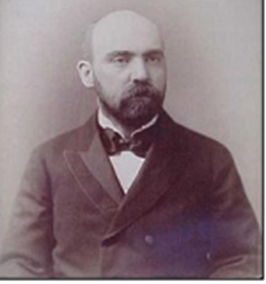
A prominent lawyer in Elmira, N.Y., Hill had steadily madehis way up the ranks of the Empire State’s Democratic Party. He was elected tothe State Assembly in 1870, where he became a close associate of DemocraticGovernor Samuel J. Tilden, who later became the Democratic nominee againstRutherford B. Hayes in the infamous disputed presidential election of 1876.
Hill was elected mayor of Elmira in 1882. Later that year, he ranfor Lieutenant Governor and won, getting more votes than the Governor, GroverCleveland. When Cleveland was elected to the presidency two years later, Hill filledout the rest of Cleveland’s gubernatorial term.
David Hill won the 1890 election tothe U.S. Senate while he still was New York’s Governor, but chose to stay inthat office for more than a year, not taking his seat in the U.S. Senate untilJanuary of 1892.
Vice President Stevenson (1835-1914)—the grandfather of Adlai EwingStevenson II, the governor of Illinois and the Democratic presidential nomineein 1952 and 1956—also was a national Democratic Party bigwig.
An Illinois congressman in the 1870s and 80s, he went on to serve as AssistantPostmaster General (a politically powerful job in those days) during the first Cleveland Administration after which the party chose Stevensonto be Grover Cleveland’s running mate in 1892.
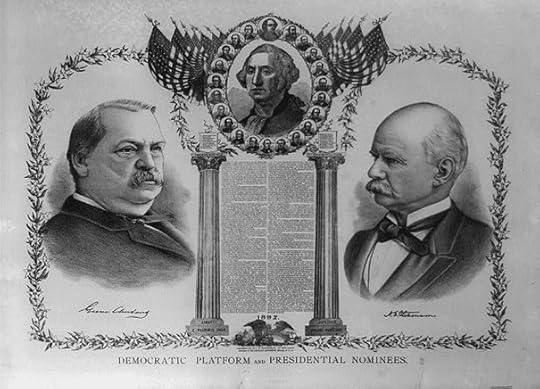
It's very likely that the visit to Monticello by those twoDemocratic Party heavy hitters in 1894 played a role in Jefferson Levy’sdecision five years later to jump into national politics and run for Congress.At the very least, Hill and Stevenson definitely were impressed by the factthat Levy owned Thomas Jefferson’s Monticello and that he was among thewealthiest men in the country—and someone who had the wherewithal to entertainguests lavishly.
After returning to Washington, Hill told an Alexandria (Va.) Gazettereporter that the trip to Monticello “was a delightful one” and that Levy’shospitality “is not only bounteous but magnificent and that he entertains elegantly.”
During the last night of their short stay, Hill told the reporter that “alarge number of the people of Charlottesville and vicinage [very likely DemocraticParty supporters] rode out to the Monticello to call” on him and Stevenson andthat both of them “addressed” the group.
The only fly in the ointment, the newspaper said, was that Hill said he “didn’tsleep well” upstairs in the small, octagonal guest bedroom known as “Mr.Madison’s Room,” in honor of the fact that James and Dolly Madison often spent the night there indays gone by.
EVENTS: On Thursday, November 14, I’ll be doing atalk on the life of the Marquis de Lafayette, based on my 2011 concisebiography, Lafayette: Idealist General, in a fund-raising event for theVirginia Piedmont Heritage Area, a nonprofit historic preservation organization,in Upperville, Va. To register, go to https://bit.ly/VPHALafayetteTalk
On Tuesday, November 19,I’ll be joining Susan Stein, Monticello’s Senior Curator for Special Projects, atthe Metropolitan Club in Washington, D.C., for a showing of Steven Pressman’sgreat documentary, “The Levys of Monticello,” followed by a discussion of thefilm, which was inspired by Saving Monticello.
I will be doing more events in December and in2025, including talks on Saving Monticello. I also will be doing talksand media interviews starting in early December for my new book, TheUnlikely War Hero. It’s a slice-of-life biography of the extraordinaryVietnam War story of Doug Hegdahl, the youngest and lowest ranking Americanprisoner held in Hanoi during the war. More info at https://bit.ly/Hegdahl

If you’d like to arrange a talk on that book, on SavingMonticello, or any of my other books, feel free to email me at marcleepson@gmail.com Fordetails on upcoming events, check the Events page on my website: marcleepson.com/events
COMMERCE: I have brand-new paperback copies of Saving Monticello and a few as-newhardcovers. To order personalized, autographed copies, go to https://bit.ly/BookOrdering or email me directly at marcleepson@gmail.com
I also have a stack of six of my other books: Flag: An American Biography; Desperate Engagement; What So Proudly WeHailed; and Ballad of the Green Beret, and Huntland.
October 10, 2024
October 2024
Saving Monticello: The Newsletter
The latest about the book, author events, and more
NewsletterEditor - Marc Leepson

Volume XXI, Number 10 October2024
[image error]
A SUMMER RESORT: The story of how JeffersonMonroe Levy gained control of Monticello in 1879 after more than two decades oflegal wrangling among himself and his Uncle Uriah Levy’s other heirs is a longand winding one. And one with a surprising conclusion.It began shortly after Uriah Levy’s death on March 22, 1862,when his heirs—more than 60 of them—discovered that the Commodore unexpectedly bequeathedMonticello to the people of the United States to be used as an agriculturalschool for the orphans of Navy warrant officers.
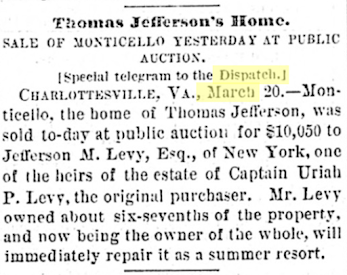
That didn’t happen because Congress,which would have had to approve the idea, had little time to deal with a realestate matter during the darkest days of the Civil War.
The will stipulated that if Congress did not green lightthat plan, Monticello should go to the state of Virginia for the same purpose. Virginia,by then no longer in the Union, took no action—even though the South had confiscatedMonticello in 1861 since it was owned by a northerner.
The will had a third contingency; if Virginia said no, thenJefferson’s Charlottesville property would go to the Portuguese Hebrewcongregations of New York, Philadelphia, and Richmond to be used as anagricultural school for orphans, both Jewish and non.
With no action on the synagogue front, family members in 1868filed partition lawsuits in Virginia and New York (where UPL lived most of the time)—thekind often used in contested divorce proceedings—to try to clear up Monticello’sfate. That year, courts in Richmond and New York ruled that Levy’s stipulationthat Monticello would become a school for orphans was invalid. The courts then orderedthat Monticello should be auctioned on the premises. The proceeds would then bedivided among Uriah Levy’s many heirs, who were allocated shares in the ownershipof the property.
At the time of the court decision, Jefferson Monroe Levywas sixteen-and-a-half years old.
Whatfollowed was more than a decade of more legal wrangling over Monticello’s fate.Things were not settled, as I noted in Saving Monticello, until 1879. Andit wasn’t a court ruling that did it.
Jefferson Monroe Levy had in the intervening years made a fortuneas a big-time real estate and stock speculator. And he decided to take the fateof Monticello into his own hands beginning in the mid-1870s, and started buyingout other family members’ inheritance shares.
In June 1875, Jefferson Levy he bought the Monticelloinheritance shares of Virginia Lopez Levy Ree—Uriah Levy’s remarried widow—alongwith those of her husband, William J. Ree. In March 1876. JML purchased his parents,Fanny Jonas Phillips Levy’s Monticello shares.
Then, in October 1876. Levy bought the shares of VirginiaRee’s brother George Washington Lopez of Spanish Town, Jamaica. By April the following year, Jefferson Levy (below) hadaccumulated about half of Monticello’s shares.
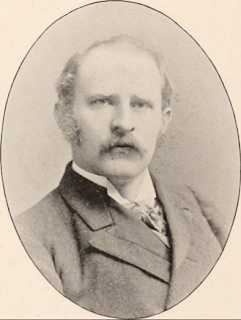
It is not a matter of recordexactly how much Jefferson Levy paid the other heirs for their shares. The bestguess is that it was approximately $10,000—a not insignificant sum in the late1870s.
On February 5, 1879, Levyfamily lawyer George Carr, an executor of Uriah Levy’s estate, placed an ad in aCharlottesville newspaper. Itannounced that Monticello and its surrounding acreage would be offered forsale “at public auction, to the highest bidder on the premises between 11 o’clockA.M., and 2 o’clock P.M., on Thursday, March 20th.”
It appears that JeffersonMonroe Levy, a month shy of his 27th birthday, was the only bidderat the March 20 auction. His winning bid was $10,050. That money was distributedto the other heirs.
But since Levy had bought outlarge portions from some of the other heirs, he received a good percentage ofthe purchase price. Jefferson Levy, in other words, had more or less boughtMonticello from himself.
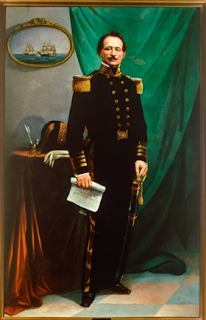 CORRECTION: In last month’s newsletter I mentioned in passing that a full-lengthportrait of Uriah Levy in his Navy uniform (below) that had hung inMonticello was on display at the U.S. Naval Academy’s Museum in Annapolis. JeffersonMonroe Levy’s sister Amelia Mayhoff, who inherited the painting after his deathin 1924, had donated the portrait to the Naval Academy in 1928. She did soafter the Thomas Jefferson Foundation, which bought the house from Levy in 1923, turneddown her offer to keep it on kept on display in the house.
CORRECTION: In last month’s newsletter I mentioned in passing that a full-lengthportrait of Uriah Levy in his Navy uniform (below) that had hung inMonticello was on display at the U.S. Naval Academy’s Museum in Annapolis. JeffersonMonroe Levy’s sister Amelia Mayhoff, who inherited the painting after his deathin 1924, had donated the portrait to the Naval Academy in 1928. She did soafter the Thomas Jefferson Foundation, which bought the house from Levy in 1923, turneddown her offer to keep it on kept on display in the house.
EVENTS: Two scheduled for this month:
On Wednesday, October 16, I’ll bedoing a talk on Saving Monticello for the McLean (Virginia) Newcomersand Neighbors Club.
On Sunday, October 20, I have talkand book signing at the Thomas Balch Library in Leesburg, Virginia, on my secondhouse history book, Huntland. It begins at 2:00 in the afternoon, and isfree and open to the public. Registration is required, though. To doo so, call 703-737-7195, email balchlib@leesburgva.gov or go to https://tinyurl.com/TBLEvents
I will be doing more events in the fall andwinter, and in 2025, including talks on Saving Monticello. I also willbe doing talks and media interviews starting in early December for my new book,The Unlikely War Hero, a slice-of-life biography of the extraordinary VietnamWar story of Doug Hegdahl, the youngest and lowest ranking American prisonerheld in Hanoi during the war. More info on that book at https://bit.ly/Hegdahl
If you’d like to arrange a talk on thatbook, on Saving Monticello, or any of my other books, feel free to emailme at marcleepson@gmail.com
For details on upcoming events, check theEvents page on my website: marcleepson.com/events

COMMERCE: Ihave brand-new paperback copies of SavingMonticello and a few as-new hardcovers. To order personalized, autographedcopies, go to https://bit.ly/BookOrdering or email me directly at marcleepson@gmail.com
I also havea stack of six of my other books: Flag:An American Biography; Desperate Engagement; What So Proudly We Hailed; and Ballad of the Green Beret, and Huntland.
You canread back issues of this newsletter at http://bit.ly/SMOnline
September 13, 2024
September 2024
The latestabout the book, author events, and more
NewsletterEditor - Marc Leepson
VolumeXXI, Number 9 September2024

A ‘Heroic Man’ and‘Noble Officer’: Uriah Levy’s death in his 70th year onMarch 22, 1862,* at his New York City East Village residence, 105 St. Mark’sPlace, spawned headlines and accolades in newspapers in New York and Virginia,where he lived.
The Richmond, Virginia. DailyDispatch, in reporting Levy’s demise, for example, described him as “a manof good personal appearance” and “refined education” (although UPL had littleformal schooling), and opined that he was “distinguished for many acts ofpersonal bravery.”
The article also noted that Uriah Levy “was the owner ofMonticello, Jefferson’s residence in Virgina.” He was the owner in thatnewspaper’s view, because the Confederate States of America had confiscatedMonticello after the Civil War began a year earlier as it was owned by anortherner. When Levy died, his lawyers had been contesting that seizure in theConfederate courts for about a year, a lawsuit that they would lose in the fallof 1864.
Back in March of 1862, The New York Times and TheNew York Hearld ran laudatory obits. The Herald described UriahLevy as “a sterling American patriot” and “a heroic man and noble officer,” anddidn’t stop there. A “faithful naval officer,” the paper said, he was known forhis bravery and “the honesty of his character and motives.”
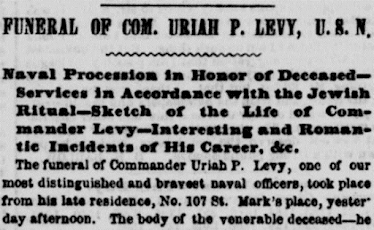
Both newspapers provided details of his funeral, whichstarted in the parlor of his house on St. Mark’s Place in New York, and which Ibriefly described, based on those articles, in Saving Monticello.
I wrote in the book thatLevy had a Jewish funeral with patriotic flourishes and that Rabbi Jacques Judah Lyons, of New York’s SephardicCongregation Shearith Israel (which the Herald described as “theWest Nineteenth street synagogue congregation”), presided at the funeral.
I didn’t report that Levy was laid out in a plain rosewoodcoffin. Nor that on its lid, the Heraldnoted, “were placed the sword, hat and coat of the deceased, while a solitarycandle burned at the head and feet of the same. The parlor where the body reposed,and the bedchambers leading thereto were crowded with sympathizing friends andnaval officers.”
A large, full-length portrait of the Commodore hung on oneof the walls of his house. Said portrait (in photo below) later was shippedto Monticello, and today resides in the U.S. Naval Academy Museum in Annapolis.
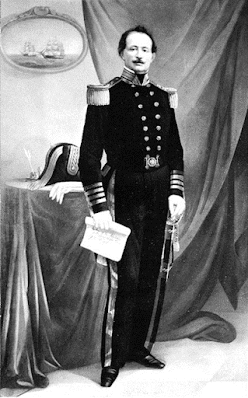
Uriah Levy’s niece, Amelia Mayhoff, donated the portrait tothe Academy following the death of her brother, Jefferson Levy, a few monthsafter he sold Monticello to the Thomas Jefferson Memorial Foundation in December1923.
The Rev. Mr. Lyons, as he was referred to in the newspapers,led the assembled in prayer at the house. Then, at around 2:00 in the afternoon,six U.S. Navy pallbearers caried the casket to a hearse outside with funereal musicprovided by a 20-piece Navy Brass Band from the U.S.S. North Carolina, a74-gun ship of the line docked in New York that had been in service since 1820.
A “large crowd of persons” stood outside the house to paytheir respects. Three companies ofMarines and a detachment of eighty sailors from the North Carolina accompaniedthe funeral hearse and carriages filled with family andfriends as they moved slowly to the old dock at Grand Street, and then onto aferry boat that took them across the East River to the Williamsburg section ofBrooklyn. The procession then made its way to Uriah Levy’s final resting place,Beth Olam Cemetery (below), then known as Cypress Hill Cemetery), whichstraddles the border between Brooklyn and Queens.
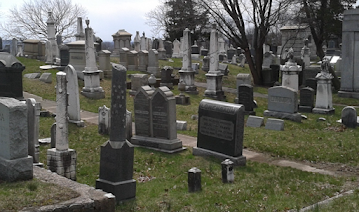
Arriving at the cemetery, The Times reported, “the deceased was placed in the receiving-house,when the mourners, in accordance with Jewish custom, made the circuit of itseven times, chanting verses illustrative of the mercy of God and the mortalityof man.”
The casketthen “was lowered into the grave wherethe nearest relatives offered a prayer, threw dust upon the coffin and theobsequies were finished.”
As I noted in the November2020 Newsletter, Uriah Levy left specific instructions for the monument hewanted over his grave. He envisioned a full-length, life-sized statue ofhimself, either in iron or bronze, standing on a single block of granite sunkthree feet in the ground.
He specificized that the stature depicted him in thefull uniform of a U.S. Navy captain, holding a scroll in his hand. The scrollwas to be inscribed: “Uriah P. Levy, Captain in the United States Navy, Fatherof the law for the abolition of the barbarous practice of corporal punishmentin the Navy of the United States.”
But that was not to bebecause Shearith Israel decided that statues of the deceased are notappropriate in Jewish cemeteries. The request for a life-sized statue, “causedthe congregation some discomfort,” according to the Shearith Israelwebsite’s Beth Olam Cemetery page, which notes that while it is important to honor the wishes of thedeceased, it is also prohibited by halakha [Jewish law based on theTalmud] to erect a statue in human form.”
Instead, the marble monument (below)features a flag-draped column adorned with a bas relief of a sailing ship andother naval and patriotic imagery.
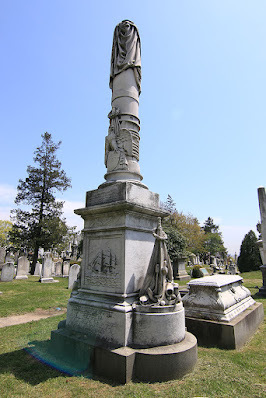
The epitaph, however, isnearly the same as what Uriah Levy envisioned. It reads: “In memory of Uriah P.Levy, Father of the Law for the abolition of the barbarous practice of corporalpunishment in the Navy of the United States.”
*As I was fact-checking this, I saw that the Uriah LevyWikipedia page listed his date of death as March 26, 1862. I knew that was incorrectbecause I had read a short death notice in the March 24, 1862, New YorkHerald—plus, 25 years ago when I was researching Saving Monticello, Ifound other solid evidence that Levy died on March 22 and said so in the book.

But to triple check, I went to Find-a-Grave hoping there’dbe an image of his giant gravestone. There was. And that confirmed the date ofhis death as March 22. Then I did what any historian would do: I changed thedate to the correct one on Wikipedia.
EVENTS: Nonescheduled for September, but I will be doing more events in the fall and winter,including talks on Saving Monticello. I also will be doing talks andmedia interviews starting in early December for my new book, The UnlikelyWar Hero, a slice-of-life biography of the extraordinary Vietnam War storyof Doug Hegdahl, the youngest and lowest ranking American prisoner held inHanoi during the war.

If you’d like to arrange a talk on thatbook, on Saving Monticello, or any of my other books, feel free to emailme at marcleepson@gmail.com
For details on upcoming events, check theEvents page on my website: marcleepson.com/events
COMMERCE: Ihave brand-new paperback copies of SavingMonticello and a few as-new hardcovers. To order personalized, autographedcopies, go to https://bit.ly/BookOrdering or email me directly at marcleepson@gmail.com
I also havea stack of six of my other books: Flag:An American Biography; Desperate Engagement; What So Proudly We Hailed; Flag: An American Biography; Ballad of the Green Beret, and Huntland.
August 4, 2024
August 2024
Saving Monticello: The Newsletter
The latest about the book, author events, and more
NewsletterEditor - Marc Leepson

Volume XXI, Number 8 August 2024
A VALIANT OFFICER; AN ACCOMPLISHEDGENTLEMAN: I included adetailed account in Saving Monticello and in this newsletter over theyears of how Uriah Levy, while on an extended leave in Paris in the early 1830sduring his U.S. Navy career, sought out the famed French sculptor
and commissioned a larger-than-life statue of Thomas Jefferson.
Andhow Levy brought the statue home to the U.S. early in 1834, presented a plastermodel to the City of New York, and donated the seven-and-a-half-foot bronzeoriginal to the people of the United States.
Andhow the House and Senate accepted the gift and displayed the statue in theCapitol, then later in front of the White House, and ultimately brought it backto the Capitol, where it stands today in the Rotunda, the only statue in thebuilding donated by a private citizen.
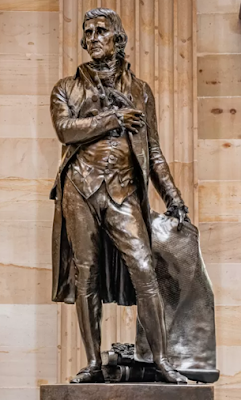
Inthe book I also covered in detail how in the fall of 1833 or early in 1834Uriah Levy spotted a newspaper advertisement by Monticello’s then owner, JamesTurner Barclay, saying that the “celebrated… former residence of Mr. Jefferson isoffered for sale.”
Andthat Levy made his way to Charlottesville, sought out Barclay, and on April 1,1834, signed a contract to purchase Monticello and its surrounding acreage.
Ibased the account of his time in Paris and the commissioning of the statue—fromthe fall of 1832 to early 1834—and what immediately came after on variedsources, including legal documents, newspaper articles, and congressionalrecords. But I found some new information (to me) about the statue and aboutUriah Levy recently after coming upon an article that I had not seen before inthe April 4, 1834, Alexandria Gazette on the Library of Virginia’sonline Virginia Chronicle state historical newspaper database.

Underthe above headline, the article, written by the unidentified (as was thejournalistic custom of the day) Boston Post Washington correspondent,came out just three days after Levy and Barclay signed the paperwork for thesale of Monticello. Although that historic fact was not mentioned, I wasfascinated to read, for the first time, an article written during thatimportant week in Monticello’s history—and in Uriah Levy’s life.
I’mhappy to report that virtually all the facts in the article were accurate. The “new”information included the correspondent mentioning that the big bronze Jeffersonstatue came in at “52 cwt." That’s 52 hundredweight, or about 5,200 pounds. And that it probably cost Uriah Levy $14,000-$15,000.
Notingthat bronze is a “costly material,” the correspondent wrote that he gleaned thelikely price from “those who profess to be acquaintedwith the value of this kind of statuary, Checking several online inflationcalculators, $15,000 in 1834 would be the equivalent of atleast $500,000 today.
Levy, the article went on to say, “refuses to tell what it cost. He has thehonor, whatever it may cost, of bestowing upon his fellow citizens the firststatue of bronze that has ever been possessed in this country; and one too, of one of the first and greatestmen of which this country can boast.”
The writer then described Levy’s heritage without mentioning the word “Jewish.”Saying Levy was a native of Philadelphia, which he was, and “a resident ofVirginia,” which he wasn’t, the correspondent elaborated: “He is a descendant of the Maccabees, and a countrymanof Isaiah.
"He belongs to a race to whom, in Europe, Napoleon first extended therights of citizenship; and whose example England has lately attempted tofollow; on whom the constitution of this country has bestowed all theprivileges of its trusts and honors; whose example every State in the Union,except Maryland, has followed.”*
Then the writer lavished praise on Levy’snaval service, saying, “he is known as avaliant officer and an accomplished gentleman.”And he provided a physical description, that UPL was “about the middling height, say 5 feet 9, fine proportioned, darkcomplexion, with nothing very peculiar in his countenance, but a dark andpiercing eye.” (Below: a photograph of UPL circa 1860 and a portrait of him circa 1815 as a young U.S. Navy Sailing Master)
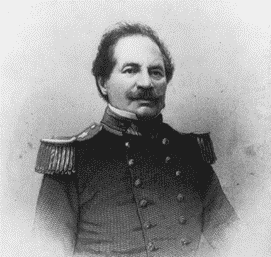
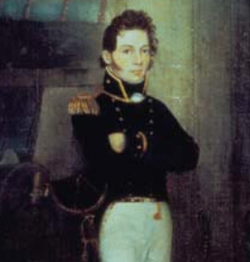
Levy was “apparently from thirty-seven to forty years of age,” the correspondent wrote. He was close; UPL was in his 42nd year. “He has spent considerable time in France and Germany on leave of absence, and acquired so much of a foreign accent, that, together with his mustache, he would not be taken for an American.”
In more than 25 years of studying theLevys, I have not found a whit of evidence that the Philadelphia-born Uriah P.,a fifth-generation American, had any kind of “foreign accent.” Except, that is,in a discredited 1897 newspaper article that later became a pamphlet written bya New York journalist, Amos Cummings. Said article was little more than a vile,thinly veiled anti-Semitic attack on Jefferson M. Levy, who then ownedMonticello, and his uncle, and contains made-up dialogue with Uriah speaking insome sort of Yiddish-German accent.
As for the Boston Postcorrespondent, he ended his article with effusive praise for Uriah Phillips Levy. To wit: His “munificence, and patriotism and valor areplenary evidence of his undisputed claim to American birth and citizenship.”
* Maryland’s 1649 An Act Concerning Religion allowedonly people who “believe[d] in Jesus Christ” to practice their religion in thecolony. The state’s Constitution adopted in 1776 provided only that “personsprofessing the Christian religion are equally entitled to protection in theirreligious liberty.” That stricture remainedin effect until the Maryland House of Delegates passed a law in 1826 thatextended “the sect of people professing the Jewish religion the same rights andprivileges that are enjoyed by Christians.”
EVENTS: None scheduled for August orSeptember, but I will be doing more book talks and other events in the fall andwinter. If you’d like me to do a talk on Saving Monticello or any of my otherbooks, feel free to email me at marcleepson@gmail.com For details on events starting inOctober, go to marcleepson.com/events
COMMERCE: To order a new, personally inscribed paperback of Saving Monticello, go to my website at https://bit.ly/BookOrdering or email me at marcleepson@gmail.com I also have a few lightly used SavingMonticello hardcovers, and a stack of six of my other books: Flag: An American Biography; DesperateEngagement; What So Proudly We Hailed; Flag:An American Biography; Ballad of theGreen Beret, and Huntland.July 12, 2024
July 2024
Saving Monticello: The Newsletter
The latest about the book, author events, and more
Newsletter Editor - Marc Leepson
Volume XXI, Number 7 July 2024

EARLY IMAGES: Twenty-five years ago, I was immersed in doing the research for the bookthat would become Saving Monticello. That research included searchingfor historical images of the house and grounds, along with images of the notablepeople who lived, worked, and visited there. I came across more than two dozen photographsand other images, 19 of which are in the book.
That includes the image on the cover of the hardcover and paperback—theoldest known photograph of Monticello, which dates from around 1870. Taken byWilliam Roads, a Charlottesville photographer, the original photograph is archivedin the Special Collections of the University of Virginia Alderman Library,which is where I found it, along with another of Roads’ images of Monticello takenat the same time. Since then, no older photographs of Monticello have surfaced.
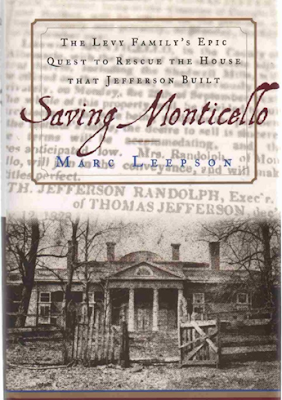
I included old photos of Monticello’s post-Jeffersonowners—Benjamin Franklin Ficklin, James Turner Barclay, Uriah Phillips Levy,and Jefferson Monroe Levy—in the book. And since its publications in 2001, whileputting together this newsletter, I’ve discovered additional images of the Levys,as well as their families and other visitors to the mountaintop, a good numberof which have been digitized since the book came out.
Which brings us to the news of a recently discovered vintagephoto of a prominent and frequent Monticello late eighteenth and early nineteenthcentury visitor, the famed First Lady, Dolley Madison. Earlier this year, afamily found the photograph—a daguerreotype—which was taken in 1847, making itthe oldest photo of a U.S. First Lady. It’s at least 30 years older than theone on the book’s cover
Accordingto newspaper reports, the anonymous family discovered the image earlier thisyear when cleaning a “dead relative’s basement,” sent it to Sotheby’s, and thebig auction house’s experts determined that the image was taken by a Virginia photographer named JohnPlumbe, Jr. in 1847, when DolleyMadison was in her seventy-ninth year. Plumbe sold his photography business thenext year.
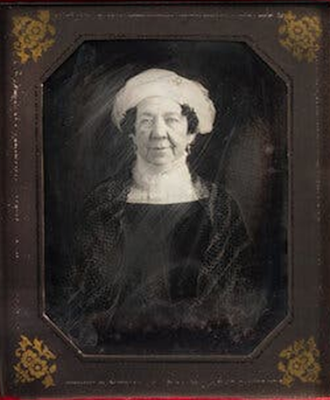
The image went to auction earlierthis summer, and the Smithsonian’s National Portrait Gallery snapped it up for $456,000.The photo will go on view at the Portrait Gallery in 2026, as the nationcommemorates the semiquincenntenial (250th) anniversary of thesigning of the Declaration of Independence, after which it will become part ofthe museum’s permanent collection.
“This artifact will providethe Smithsonian another opportunity to tell a more robust American story,” SmithsonianSecretary Lonnie G. Bunch III, said, “and illuminate the vital role women likeMadison have played in the nation’s progress.”
The Portrait Gallery also has in its collection theoldest known photograph of a U.S. president. It’s another daguerreotype, thisone of John Quincy Adams in Washington, D.C., taken in March 1843 by the photographerPhilip Haas, just four years after that photography process which uses copperplates lined with a thin sliver of silver to create images was invented. It hasbeen on display at the D.C. museum since 2018. J.Q. Adams, who served as the sixthPresident from 1825-29, was a member of the U.S. House of Representatives fromMassachusetts at the time.
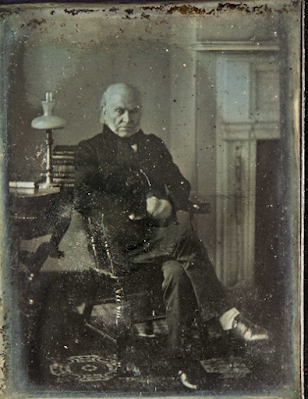
Both Dolley Madison and her husbandJames, who lived in Montpelier about 30 miles north of Monticello, had strong tiesto Thomas Jefferson and Monticello.
Before James Madisonsucceeded Jefferson as the nation’s fourth president in 1809, his wife helpedthe widowed Jefferson host social events at the White House (then known as thePresident’s House) while her husband was serving in the House ofRepresentatives on the other side of Pennsylvania Avenue.
Dolley Madison soon became famousfor her lively, weekly receptions at the White House for the political andsocial movers and shakers in the Nation’s Capital.
The Madisons also werefrequent visitors and guests at Monticello, before and after Jefferson’spresidency. So frequent that Jefferson’s grandchildren—his daughter Martha Randolph’soffspring—who lived at Monticello named one of the upstairs bedrooms “Mr.Madison’s Room” even though both Mrs. and Mr. Madison stayed there often,sometimes as long as several weeks at a time.
There is no record of John Q.Adams visiting the Mountaintop. However, he did attend dinners and other socialevents at the White House when Jefferson was in office from 1801-09.
And, as I wrote in SavingMonticello, when he heard the news that his father and Jefferson both diedon July 4, 1826, the 50th anniversary of the founding of the nation,J.Q. Adams memorably wrote in his diary that both founding fathers dying on thatnotably day was a “visible andpalpable” manifestation of “Divine favor.”
EVENTS: Just one scheduled this month. On Saturday,July 13, I’ll be speaking about the Civil War Battle of Monocacy andConfederate General Jubal Early’s subsequent attack on Washington, D.C., at theFort Stevens Day event in Northwest D.C. near Silver Spring, Maryland. It’s a commemoration of the 160th anniversary of the fighting that went on there on July 11-12, 1864. It’s freeand open to the public. For more info, go to https://theparksdc.com/event/fort-stevens-day-160-anniversary
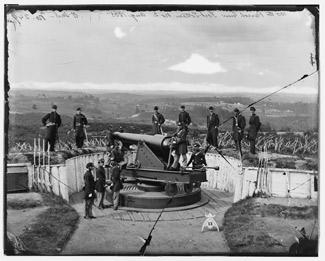
I will have more events in the fall andwinter. For details, check the Events page on marcleepson.com/events
COMMERCE: Ifyou would like a new paperback of SavingMonticello, I have a few on hand. To order that book, or the just-publishedhardcover of Huntland, go to this page on my website https://bit.ly/BookOrdering or email me at marcleepson@gmail.com
I also havea few used Saving Monticello hardcovers, and a stack of five of my otherbooks: Flag: An American Biography;Desperate Engagement; What So Proudly We Hailed; Flag: An American Biography; and Ballad of the Green Beret.
Saving Monticello: The NewsletterThe latest about the b...
Saving Monticello: The Newsletter
The latest about the book, author events, and more
Newsletter Editor - Marc Leepson
Volume XXI, Number 7 July 2024

EARLY IMAGES: Twenty-five years ago, I was immersed in doing the research for the bookthat would become Saving Monticello. That research included searchingfor historical images of the house and grounds, along with images of the notablepeople who lived, worked, and visited there. I came across more than two dozen photographsand other images, 19 of which are in the book.
That includes the image on the cover of the hardcover and paperback—theoldest known photograph of Monticello, which dates from around 1870. Taken byWilliam Roads, a Charlottesville photographer, the original photograph is archivedin the Special Collections of the University of Virginia Alderman Library,which is where I found it, along with another of Roads’ images of Monticello takenat the same time. Since then, no older photographs of Monticello have surfaced.

I included old photos of Monticello’s post-Jeffersonowners—Benjamin Franklin Ficklin, James Turner Barclay, Uriah Phillips Levy,and Jefferson Monroe Levy—in the book. And since its publications in 2001, whileputting together this newsletter, I’ve discovered additional images of the Levys,as well as their families and other visitors to the mountaintop, a good numberof which have been digitized since the book came out.
Which brings us to the news of a recently discovered vintagephoto of a prominent and frequent Monticello late eighteenth and early nineteenthcentury visitor, the famed First Lady, Dolley Madison. Earlier this year, afamily found the photograph—a daguerreotype—which was taken in 1847, making itthe oldest photo of a U.S. First Lady. It’s at least 30 years older than theone on the book’s cover
Accordingto newspaper reports, the anonymous family discovered the image earlier thisyear when cleaning a “dead relative’s basement,” sent it to Sotheby’s, and thebig auction house’s experts determined that the image was taken by a Virginia photographer named JohnPlumbe, Jr. in 1847, when DolleyMadison was in her seventy-ninth year. Plumbe sold his photography business thenext year.

The image went to auction earlierthis summer, and the Smithsonian’s National Portrait Gallery snapped it up for $456,000.The photo will go on view at the Portrait Gallery in 2026, as the nationcommemorates the semiquincenntenial (250th) anniversary of thesigning of the Declaration of Independence, after which it will become part ofthe museum’s permanent collection.
“This artifact will providethe Smithsonian another opportunity to tell a more robust American story,” SmithsonianSecretary Lonnie G. Bunch III, said, “and illuminate the vital role women likeMadison have played in the nation’s progress.”
The Portrait Gallery also has in its collection theoldest known photograph of a U.S. president. It’s another daguerreotype, thisone of John Quincy Adams in Washington, D.C., taken in March 1843 by the photographerPhilip Haas, just four years after that photography process which uses copperplates lined with a thin sliver of silver to create images was invented. It hasbeen on display at the D.C. museum since 2018. J.Q. Adams, who served as the sixthPresident from 1825-29, was a member of the U.S. House of Representatives fromMassachusetts at the time.

Both Dolley Madison and her husbandJames, who lived in Montpelier about 30 miles north of Monticello, had strong tiesto Thomas Jefferson and Monticello.
Before James Madisonsucceeded Jefferson as the nation’s fourth president in 1809, his wife helpedthe widowed Jefferson host social events at the White House (then known as thePresident’s House) while her husband was serving in the House ofRepresentatives on the other side of Pennsylvania Avenue.
Dolley Madison soon became famousfor her lively, weekly receptions at the White House for the political andsocial movers and shakers in the Nation’s Capital.
The Madisons also werefrequent visitors and guests at Monticello, before and after Jefferson’spresidency. So frequent that Jefferson’s grandchildren—his daughter Martha Randolph’soffspring—who lived at Monticello named one of the upstairs bedrooms “Mr.Madison’s Room” even though both Mrs. and Mr. Madison stayed there often,sometimes as long as several weeks at a time.
There is no record of John Q.Adams visiting the Mountaintop. However, he did attend dinners and other socialevents at the White House when Jefferson was in office from 1801-09.
And, as I wrote in SavingMonticello, when he heard the news that his father and Jefferson both diedon July 4, 1826, the 50th anniversary of the founding of the nation,J.Q. Adams memorably wrote in his diary that both founding fathers dying on thatnotably day was a “visible andpalpable” manifestation of “Divine favor.”
EVENTS: Just one scheduled this month. On Saturday,July 13, I’ll be speaking about the Civil War Battle of Monocacy andConfederate General Jubal Early’s subsequent attack on Washington, D.C., at theFort Stevens Day event in Northwest D.C. near Silver Spring, Maryland. It’s a commemoration of the 160th anniversary of the fighting that went on there on July 11-12, 1864. It’s freeand open to the public. For more info, go to https://theparksdc.com/event/fort-stevens-day-160-anniversary

I will have more events in the fall andwinter. For details, check the Events page on marcleepson.com/events
COMMERCE: Ifyou would like a new paperback of SavingMonticello, I have a few on hand. To order that book, or the just-publishedhardcover of Huntland, go to this page on my website https://bit.ly/BookOrdering or email me at marcleepson@gmail.com
I also havea few used Saving Monticello hardcovers, and a stack of five of my otherbooks: Flag: An American Biography;Desperate Engagement; What So Proudly We Hailed; Flag: An American Biography; and Ballad of the Green Beret.
June 20, 2024
June 2024
The latestabout the book, author events, and more
NewsletterEditor - Marc Leepson
VolumeXXI, Number 6 June2024

JML & THE UDC: In mid-November 1912 the battle between Jefferson Levy andhis supporters and Maude Littleton and her backers over her well-financed planto have the government assert eminent domain, confiscate Monticello, and turnit into a government-run house museum was reaching a crescendo.
A bill that Mrs. Littleton (as she was referred to in thenewspapers of the day) and her allies on Capitol Hill had written would doexactly, and it would soon be coming up for a vote in the House ofRepresentatives. The bill came out of a series of bombastic hearings during thesummer and fall in which the two camps—led by Maude Littleton and the congressmensupporting her effort, and by Jefferson Levy and his lawyer, Judge Tom Duke ofCharlottesville—verbally sparred over Monticello’s fate.
As the adversariesworked to gain support before the vote, the United Daughters of the Confederacy—athen-influential descendants group founded in 1894 whose members were bloodrelatives of Confederate soldiers or those who supported the South’s cause inthe Civil War—came into the picture.
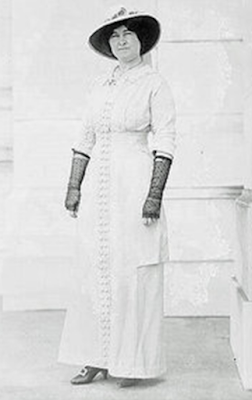
Although I wrote afair amount about other events surrounding what some people called “The War of1912” in Saving Monticello, I only recently learned new details about Mrs.Littleton’s interactions with the most-influential American hereditary groups,including the UDC and the Daughters of the American Revolution, about thepending legislation. The DAR spurned her offer to support the government-takeoverplan, but proposed an alternative, having a private group (such as the DAR) runMonticello as a house museum open to the public. As I wrote in the book, DARleaders later would make a case before Congress to do just at that. It did notcome to fruition.
Meanwhile, in November1912, the UDC briefly stepped into the Levy-Littleton imbroglio. It came about duringthe organization’s 9th annual convention at the lavish Beaux-Arts-styleWillard Hotel in Washington (in photo below) during which Mrs. Littletonshowed up to lobby UDC members to endorse her plan. But she left the city withoutaddressing the body, after the convention did not take up the matter when the proceedingsended on November 16.
Spurning Maude Littletonmay have been due to the fact that the convention received a letter fromJefferson Levy “reiterating,” a Richmond Times Dispatch reporter wrote, “hisoft-repeated declaration that he does not wish to sell the historic home.”
Inthe letter Levy also lambasted Mrs. Littleton and her supporters for “the abuse”of his family and for her “misstatements and disregard of the care I havebestowed on the property.”
At the convention’slast session, the UDC elected new members, then “applauded a statement with referenceto the right of the South to have succeeded,” as a Washington Timesreporter put it. Then came an address by a Union Civil War veteran that “hadmany of the delegates weeping” after the man spoke about the ceremonies of the dedicationof the cornerstone of a Confederate Memorial at Arlington National Cemetery aweek earlier.**
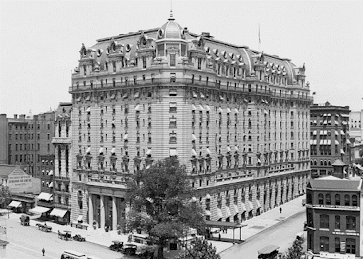
Afterthe convention ended, word got out that influential UDC members, including Mrs.Frank Anthony Walke (as the newspapers referred to her) of Norfolk, Virginia, theUDC’s Custodian of the Flags, opposed a government seizure of Monticello. But theDaughters were not averse to their organization running the property, an idea thatMrs. Walke said Jefferson Levy agreed to do at some unspecified time in thefuture.
Monticello, she tolda reporter, “belongs to Virginia in the future, and the government shall notown it. Mr. Levy has promised that the Virginia division of the [UDC] shall havethe old home of Jefferson. I have his personal assurance that the propertyshall go to us when he has finished its use.” She went on to say that she wouldoppose “any proposition for [Monticello’s] acquisition by the United Stateswhich may be advanced by Mrs. Littleton.”
Mrs. Walke then sarcasticallyadvised Maude Littleton to have “the government purchase all the historicalplaces in the North, South, East and West, and to preserve them. But Virginiacan take care of her property, particularly when it is not [on] the market.”
That didn’t exactly go over with Mrs. Littleton. “Don’t payany attention to Mrs. Walke,” she said the day after the convention ended. “Sheis just a silly, little thing—a little foolish thing—a busybody who is tryingto get even with me because I wouldn’t okay her railroad fare to Washington andher hotel expenses there.”
Then she added: “I don’tcare a row of pins about Jefferson Levy. He is nothing but a stumbling block inthe way of our great purpose. All I am thinking about is Thomas Jefferson.”
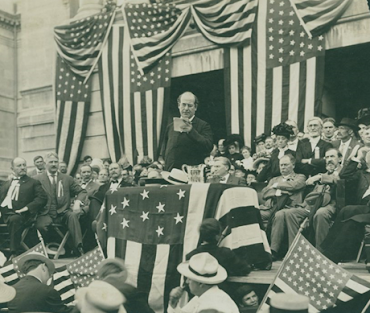
Mrs. Littleton wenton to say that the famed populist politician and orator William Jennings Bryan (above,orating) had “informed Mr. Levy” that “we are going to have Monticello.” Bryan,she said, assured her “that he would fight while he had breath in his body tohave Monticello set aside as a public memorial.”
WilliamJennings Bryan, a venerator extraordinaire of Thomas Jefferson, had written toJefferson Levy in 1897 suggesting that he sell Monticello to the federalgovernment, which would turn it into a national shrine. Six months earlierBryan, the Democratic Party nominee, had narrowly lost the 1896 presidentialelection to William McKinley
In November1912, William Jennings Bryan did, indeed, come out in support of Mrs. Littleton’scause. But Bryan, who died in 1925, never saw the government take Monticellofrom Jefferson Levy—though he (and Mrs. Littleton) did live to see the newly formednonprofit Thomas Jefferson Memorial Foundation, purchase Monticello from Levyin 1923 and begin the process of turning it into a privately run house museum.
**Thatmemorial, the largest in the cemetery, was commissioned by the UDC anddedicated in 1914. It was created by the Virginia-born sculptor and diehard formerConfederate soldier, Moses Ezekiel. The memorial was removed from the cemeteryon December 22, 2023.
EVENTS: Aside froma talk at an informal gathering of folks near where I live, I don’t have anyspeaking engagements for Saving Monticello or any of my other books inJune. In other event news, Steve Pressman’s great 2022 documentary, “The Levysof Monticello,” which was inspired by my book, is now available (with ads) forfree on Amazon Prime.
In other news, the pub date for my next book, TheUnlikely War Hero, a different kind of Vietnam War POW true story, is December17. You can get a sneak preview at https://bit.ly/PrePubInfo

And the 11th printing of the SMpaperback, published by the University of Virginia Press, is now available inbookstores and online. If you would like an autographed copy of the hardcover,I have a few on hand, along with brand-new paperbacks. To order, go to thispage on my website: https://bit.ly/BookOrdering or email me at marcleepson@gmail.com
I also have six of my other books: Flag: An American Biography; DesperateEngagement; What So Proudly We Hailed; Flag:An American Biography; Ballad of theGreen Beret; and Huntland. There’s more info on all those books on my website.
May 11, 2024
May 2024
Saving Monticello: The Newsletter
The latest about the book, author events, and more
Newsletter Editor - Marc Leepson
Volume XXI, Number 5 May 2024
STATUARY: I have been known to describe Jefferson Monroe Levy as “an early 20thcentury jetsetter” because of his frequent, first-class excursions to Europe. Inkeeping with that peripatetic lifestyle, Levy spent most of the summer of 1905on the Continent.
Near the end of thattrip, in September, as I wrote in Saving Monticello, JML was the guestof honor at an elaborate ceremony put in the historic city of Angers in the Paysde la Loire region of France. The occasion: the high-rolling real estate andstock speculator’s presentation of a replica of the David d’Angers statue ofThomas Jefferson his uncle Uriah Levy had commissioned in 1833 to the Musée David, now the Musée des beaux-arts d’Angers.
Levyhad made good on a promise he had made a year earlier to France’s Ambassador tothe United States, Jules Jusserand. During a visit to Monticello, the Frenchmanhad remarked that the city of Angers regretted not having a copy of the famed Davidstatue (below, nowdisplayed in the U.S. Capitol Rotunda), andLevy promised he’d have one fabricated. Early in the summer of 1905 JML arrangedto have the reproduction made and shipped to Angers.
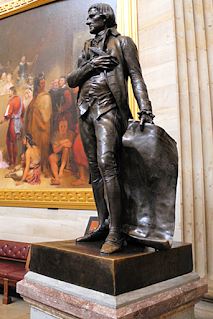
Levyand his traveling companions, the AmericanAmbassador to France Robert Sanderson McCormick (1849-1919, a nephew of the inventor, CyrusMcCormick) and the artistGeorge Torrey and his wife, took a train from Paris on September 16, andarrived in Angersfor the formalities. The Angers railwaystation was decked out for the occasion with American and French flags.
Museum officials hadplaced the Jefferson in the center of the museum’s Great Gallery surrounded by French and American flags.Special carpets were put down, hundreds of chairs brought in, and busts byDavid of George Washington and James Fenimore Cooper placed next to the larger-than-lifeJefferson statue.
Levy addressed thegathering with a short, flowery speech, in which he praised the city of Angers,the nation of France, the Marquis de Lafayette, Uriah Levy, David d’Angers,and, of course, Thomas Jefferson, whom Levy called “the greatest statesman andphilosopher of modern times.”
After a round ofchampagne and cake, the mayor gave the Levy party a tour of the museum as theband played “Yankee Doodle.” A guided tour of the town followed.
That evening, JMLwas the guest of honor at a banquet at Angers’ Grand Hotel. The next day he andthe Torreys had lunch at the American consulate and then took a train back toParis.
Jefferson Levy receivedseveral gifts from the folks in Angers, that day, including two Sevres vases anda statuette, a reproduction of the noted French painter and sculptor PaulDubois’ “Military Fortitude.”
In my ongoing questto unearth new (to me) information about Uriah and Jefferson Levy’s lives atMonticello, I recently learned more details about the Dubois statute when Icame across a front-page article in May 28, 1906, Richmond Times Dispatch,headlined, “Levy to Put French Gift in Monticello.”

I did a little digging andfound that Dubois (1829-1905) was a prolific and acclaimed French artist andsculptor, whose work in marble was influenced by his study of ItalianRenaissance sculpture. Dubois created “Military Fortitude” (also known as“Military Courage”) in 1879 as one of a group of four bronze statues for thefour corners of the ornate tomb (below) of a noted French general, Louisde la Moncière (sometimesspelled de Lamoricière), a nativeof Nantes who had died in 1865 and was entombed in the 15th century NantesCathedral.
Dubois dubbed the tomb’s other statues, which represented thedeparted general’s three other virtues, “Wisdom,” “Charity,” and “Faith.” Inthe late 1800s, a French foundry produced a fair number of reproductions of“Military Fortitude/Courage” in varying sizes.
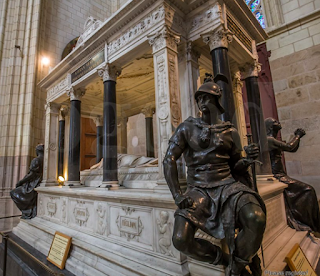 The Tomb
The Tomb
WilliamT. Walters (1820-1894), the wealthy Baltimore businessman and art collector,acquired a life-sized version. He bequeathed it to the City of Baltimore and itstands today on Mount Vernon Square, just north of Downtown Baltimore, alongwith that city’s Washington Monument, virtually overlooking the famed WaltersArt Museum. The statue Jefferson Levy received, onthe other hand. was much smaller, standing just 51 centimeters (20 inches) inheight.
Notthat the art-loving Levy didn’t have large statues displayed at Monticelloduring the time he owned the property, from 1978-1923. As I wrote in SavingMonticello, He had life-sized marble statues of what were known locally as Venus, Apollo,and Jupiter installed on the lawn.
Below are early 20th century photos of two ofthem. The first statue appears to be a copy of a classical statue of theGreek good Nemesis in the Vatican Museum. The second likely is a copy of a Roman noblewoman, although it could be Venus.
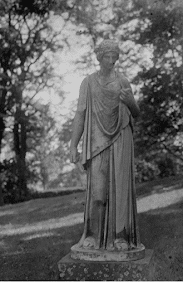
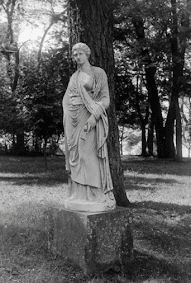
Disclaimer: I do not claim to be an arthistorian, so if you can identify these statues, I’d love to hear from you.
Coda: None of the Levy statuary remains at Monticello. Most likelyJefferson Levy’s sister Amelia, who inherited his estate after he died in March1924, disposed of them before turning the property over to the Thomas JeffersonMemorial Foundation, which had purchased it from her brother, along with itsfurniture and furnishings, in December 1923.
Onthe other hand, the Foundation may have auctioned the statues off with all ofthe other Levy furniture and furnishings after it took control of the property.In its desire to expunge all things Levy from Monticello, theFoundation held a public auction of all of its non-Jefferson contents in 1928. Thelong list of Jefferson Levy’s items the Foundation ridded itself of included tablesand chairs, sofas, carpets, chandeliers, clocks, vases, paintings, lamps, beds,bureaus, dressers, chests, and a pair of twin beds. Some of the larger itemswere shipped to New York City where they were sold at auction at the PlazaHotel.
On each item foundation officialspasted a label that said that the piece had come from Monticello during theLevy period.
EVENTS: None scheduled this month. And I’ll be taking most of the month ofJune off, mainly getting away from it all (most of it, anyway) in Charleston,S.C. Will have more events later in the summer and fall. For details, check the Eventspage on marcleepson.com/events
THE 11th PRINTING: The University of Virginia Press will soon be distributing thelatest paperback edition of Saving Monticello, which the Press beganpublishing in 2003 after the Simon & Schuster hardcover went out of print. The new eleventh printing should be available later thismonth.
During the time between printings, on April 4, I tooka peek at SM’s Amazon page and did a double take when I saw that the book’s Kindleversion was the site’s No.1 best-selling book in Historic Preservation. I took a screenshot to preserve that milestone:

If youwould like a new paperback of SavingMonticello, I have a few on hand. To order that book, or the just-publishedhardcover of Huntland, go to this page on my website https://bit.ly/BookOrdering or email me at marcleepson@gmail.com
I also havea few used Saving Monticello hardcovers, and a stack of five of my otherbooks: Flag: An American Biography;Desperate Engagement; What So Proudly We Hailed; Flag: An American Biography; and Ballad of the Green Beret. You can read back issues of thisnewsletter at http://bit.ly/SMOnline
EVENTS: None scheduled this month. And I’ll be taking most of the month ofJune off, mainly getting away from it all (most of it, anyway) in Charleston,S.C. Will have more events later in the fall. For details, check the Eventspage on marcleepson.com/events
[image error]THE 11th PRINTING: The University of Virginia Press will soon be distributing thelatest paperback edition of Saving Monticello, which the Press beganpublishing in 2003 after the Simon & Schuster hardcover went out of print. The new 11th printing should be available later thismonth. During the time between printings, on April 4, I tooka peak at SM’s Amazon page and did a double take when I saw that the book’s Kindleversion was the site’s No.1 best-selling book in Historic Preservation. I took a screenshot to preserve that milestone:
If youwould like a new paperback of SavingMonticello, I have a few on hand. To order that book, or the just-publishedhardcover of Huntland, go to this page on my website https://bit.ly/BookOrdering or email me at marcleepson@gmail.com
I also have a fewused Saving Monticello hardcovers, and a stack of five of my otherbooks: Flag: An American Biography;Desperate Engagement; What So Proudly We Hailed; Flag: An American Biography; and Ballad of the Green Beret.April 11, 2024
April 2024
Saving Monticello: The Newsletter
The latest about the book, author events, and more
Newsletter Editor - Marc Leepson
Volume XXI, Number 4 April 2024

In memory of Dan Jordan
DANIEL P. JORDAN,1938-2024: There’s no doubt in mymind that Saving Monticello would not have been the publishing successit’s been without the generosity and graciousness of Dan Jordan, who led theThomas Jefferson Foundation from 1985-2008, and could not have been morehelpful to me as I researched and wrote the book in the late nineties and afterit came out in the fall of 2001.
Dan, who died at 85 on March25, and Susan Stein, then as now Monticello’s senior curator, were my guidinglights at the Foundation.
They always took the time andeffort to answer my questions, made great research suggestions, and paved theway for the Foundation’s most-welcome and extremely important support of thebook, which continues to this day.
Among many other things forwhich I will be eternally grateful, Dan hosted my very first book talk andsigning at the old Monticello Visitor’s Center in late October 2001. Dan andSusan were extremely welcoming when we arrived on the mountaintop the afternoonof the talk and at the event itself. I can still see Dan sitting attentivelyand proudly in the audience.
Dan regularly wrote to me duringthe next seven years while he headed the Foundation. That continued after he retired,as he shared always-positive thoughts with me on the book’s success, on this newsletter—whichhe subscribed to—and on “The Levys of Monticello,” Steven Pressman’s great,award-winning 2022 documentary inspired by my book, in which Dan appeared.That’s him below in the Jefferson Library in a still from the documentary.
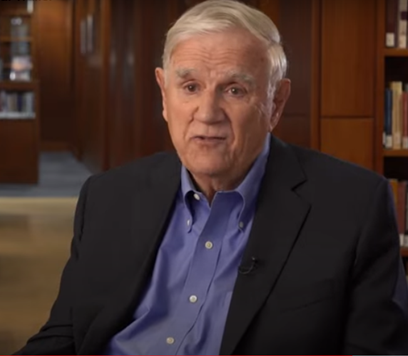
Daniel Porter Jordan, Jr. wasborn in Philadelphia, Mississippi. He was a standout baseball and basketballplayer at the University of Mississippi, majoring in English and history. He receivedhis BA and his MA in history from Ole Miss, where was elected president of thestudent body.
He trained in Army ROTC atMississippi and went on active duty after getting his MA. After getting out ofthe Army, Dan earned a Ph.D. in history from the University of Virginia in 1970.After that, he taught U.S. History, specializing in the colonial period, at theUniversity Richmond and at Virginia Commonwealth University before acceptingthe job as the head of the Thomas Jefferson Foundation in late 1984. He becamethe first historian to lead the Foundation.
Championing the Levys’ Cause
I am so thankful to Dan forhis steadfast support for my work—and for championing the Foundation’srecognition of the Levy Family’s crucial 89-year stewardship of Monticello. Dan’sadvocacy on behalf of the Levys began not long after he accepted the job at theFoundation.
I told that inspiring story ofDan’s role in recognizing the Levys in Saving Monticello, and it’s worthsummarizing here. Dan filled me in on the details when we sat down 25 years agoto discuss how it all came about. He told me that a month after he began his official duties on themountaintop on January 1, 1985, his friendSaul Viener—a Richmond businessman, biblical scholar, and historian, and thefounder of the Southern Jewish Historical Society—wrote to Rabbi Malcolm Sternin Norfolk to relay the news that Dan was the new head of the Thomas JeffersonFoundation.
“A wonderful choice,” hewrote to Rabbi Stern, who did pioneering work in Jewish-American genealogy. “WhenI phoned him congratulations, he brought up the Levy family!”
Viener, Stern, VirginiusDabney (the Pulitzer-Prize-winning editor-in-chiefof the Richmond Times-Dispatch), and Irving Lipkowitz, a longtime Richmond lawyer who also had championedthe Levys, soon thereafter “began working on Jordan,” in Stern’s words. Dancorroborated that when we spoke.
“Almost immediatelyafter the announcement I started to hear from various Jewish friends—some wereimminent scholars and some just had an interest in history—as well as fromVirginius Dabney,” Dan said, “all with the same message: namely, that animportant story was not being told at Monticello.”
His friendsconvinced him. “I looked into it. What I was told was correct," Dan toldme. “I went to the [Foundation] Board and asked about it. The Board, I think,was genuinely naive. No one could recall, in their opinions as trustees, anyissues or controversies. But all agreed that we needed to find a way to tell animportant story.”
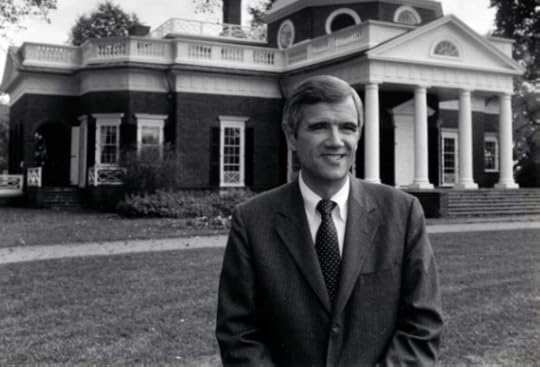
With the blessing ofthe Foundation’s Board of Trustees, Dan Jordan led the effort to have the Levys’role officially recognized at Monticello. The first step was refurbishing the gravesiteof Rachel Levy—Uriah Levy’s mother who died at Monticello in 1839 and is buriedalong Mulberry Row—and placing a plaque there honoring the family. That done,Dan planned a formal re-dedication of the gravesite.
Rabbi Stern helped the Foundation contact several Levydescendants, and on June 7, 1985, family members and several dozen guests tookpart in a joyful commemorative ceremony at Monticello.
Dan welcomed theguests, saying the occasion marked the beginning of the Thomas Jefferson Foundation’srecognition of the Levys’ “good stewardship” of Monticello.
“This morning,” hesaid, “we are pleased to honor the Levy family who, for the better part of acentury, owned and preserved this priceless estate, which is perhaps unique inour land for its combination of historic significance and scenic beauty.”
Edgar Bronfman, thehead of World Jewish Congress and CEO of Joseph E. Seagram & Sons, made theprincipal address. Bronfman, who owned a large estate in Albemarle County, hadagreed to speak at the behest of Saul Viener and Dan Jordan.
In his remarks,Bronfman focused on Thomas Jefferson and Uriah Levy. Monticello, Bronfman said,“was rescued from destruction by a Jewish-American naval officer whose ownfiery independence led him through a highly successful but storm-tossed careerin the service of his country.”
Following a scripture readingby Charlottesville’s Temple Beth Israel’srabbi, and a prayer from Louis C. Gerstein ofNew York City’s Sephardic CongregationShearith Israel (the nation’s oldest Jewish congregation where Levy familymembers worshipped), Levy descendantHarley Lewis unveiled the new plaque (in photo below)at her great-great grandmother’s grave.
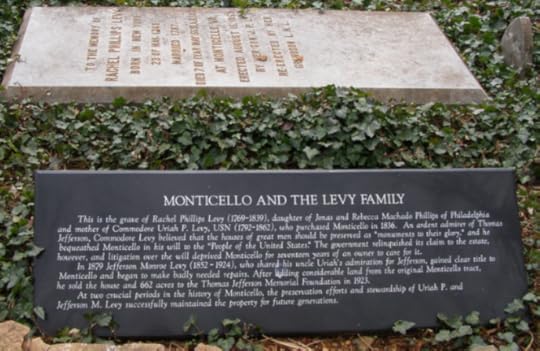
Since that auspicious day,the Foundation has taken many other steps to recognize the Levy family’s important role at Monticello. That includes anexhibit in the Robert H. and ClariceSmith Gallery at the Visitor Center and the updated, illustrated marker at Rachel Levy’s grave. (in photobelow).
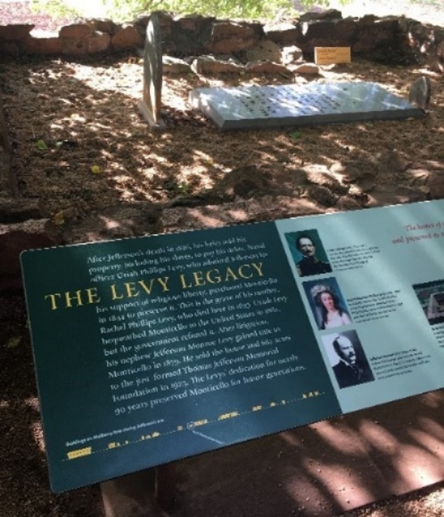
Rescuing the story of the Levys at Monticello was but one of Dan Jordan’s manyother accomplishments as head of the Foundation. As Jane Kamensky, theFoundation’s new president, wrote after his death:
DanJordan “was the most consequentialpresident on the Mountaintop since Jefferson himself. It’s no exaggeration tosay that everything we understand about modern Monticello stems from Dan’slong, fruitful, and collaborative tenure as President of the Foundation, formore than thirty years, beginning in 1985.
“A historian with a deepbelief that scholarly excellence must drive visitor experience, hepresided over the creation of the [International Center for Jefferson Studies],Getting Word, and the Jefferson Library. He then followed the scholarship whereit led: to the acceptance of Jefferson’s relationship with Sally Hemings, inmany ways the backbone of the interpretations we share today.”
Ann Lucas, Monticello’s Senior Historian Emerita, has put together astirring tribute to Dan and his work at Monticello on the Foundation’s websiteat https://bit.ly/DanJordan It includeswords of remembrance of Dan as a scholar, leader, and as a person from past andpresent Monticello staff and scholars. I am honored that Ann included my wordsin that group.
I proudly repeat my lastsentence here: Dan Jordan was, in every respect, a great man.
EVENTS: Save the date: The pub date for my next book, The Unlikely WarHero, a different kind of Vietnam War POW true story, is December 17.You can get a sneak preview at https://bit.ly/PrePubInfo
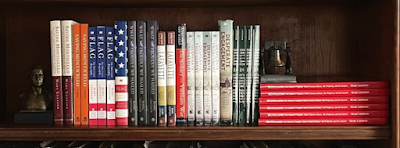
I have three in-persons events this month. OnSunday, April 14, I’ll be doing a talk on the Huntland book with thearchitectural historian Maral S. Kalbian, my indispensable collaborator, atFoxcroft School in Middleburg, Va., followed by a tour of the Huntland estate,stables, and kennels. It’s a fundraiser for the Virginia Piedmont HeritageArea. The event is sold out.
On Wednesday, April 17, I’ll be takingpart in a panel discussion. “The Life and Legacy of Francis Scott Key, Class of1796,” at St. John’s College (FSK’s alma mater) beginning at 7:30 p.m. It’sfree and open to the public. Details at https://bit.ly/FSKPanel
On Thursday, April 25, I’ll be doing a talk on the life of Key, based onmy biography, What So Proudly We Hailed, at the Glebe RetirementCommunity in Daleville, Virginia. For more details on these and future events, pleasecheck the Events page on my website: marcleepson.com/events
THE 11th PRINTING: My friends at the University of Virginia Press tell me that thepaperback Saving Monticello, which the Press began publishing in 2003after the Simon & Schuster hardcover went out of print, will be going intoits 11th printing. The paperback now is on backorder until physicalcopies come off the presses.
In the meantime, if you would like a new paperback of Saving Monticello, I have a few on hand,along with a few as-new used hardcovers.
To order thosebooks, or the recently published hardcover of Huntland, go to this pageon my website:
https://bit.ly/BookOrdering or email me at marcleepson@gmail.com
I also havea stack of five of my other books: Flag:An American Biography; Desperate Engagement; What So Proudly We Hailed; Flag: An American Biography; and Ballad of the Green Beret.
The SMNewsletter on Line: You can read back issues of thisnewsletter at http://bit.ly/SMOnline
March 25, 2024
March 2024
The latestabout the book, author events, and more
NewsletterEditor - Marc Leepson
VolumeXXI, Number 3 March2024

COLLEGE TOPICS: I was doing my usual snoopingaround online a few weeks ago, looking for hitherto undigitized primary-sourcematerial about Monticello during the Levy Family’s ownership (1834-1923), whenI saw something promising. The Library of Virginia’s Virginia Chronicle, an onlinearchive of nearly a half million issues of historical Virginia newspapers, hadjust digitized the University of Virginia’s original student newspaper, CollegeTopics, from its inception in 1890 to 1916.
I immediately went to https://bit.ly/VaChronicle (the site) andbegan searching for mentions of Jefferson Levy, who owned Monticello duringthose years—and found several articles on subjects that I’d seen before duringmy research in other publications—and a few that I hadn’t.
That latter included a short,two-paragraph item in the January 27, 1909, College Topics (below),that further buttressed what I wrote 23 years ago in Saving Monticello:that Jefferson Levy was, in the newspaper’s words, “a staunch friend of theUniversity.”
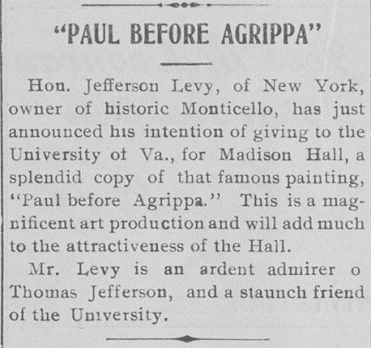
I learned of Levy’s largessto the University when I researched Saving Monticello. Among other things, as I noted inthe book, was that in April1899, in commemoration of Jefferson's birthday, Levy gave the University alarge regulator clock for its library, along with two 56-inch steel clock dialsfor the Rotunda (to replace the originals that had been destroyed in the famed 1895fire), and a device that electronically controlled the bells in all theUniversity's lecture rooms.
The 1909 article reports thatJML would be donating a “splendid” copy of a “famous painting,” St. PaulBefore Agrippa (most likely by the 18the century artist Sir James Thornhill) tothe University’s Madison Hall, which had been built in 1901 and served as thelocal YMCA headquarters.
In the early 20thcentury Madison Hall (in the vintage postcard, below), on UniversityAvenue across from the Rotunda, had also become the unofficial U-Va. studentunion. That august building today houses the office of the University’sPresident.
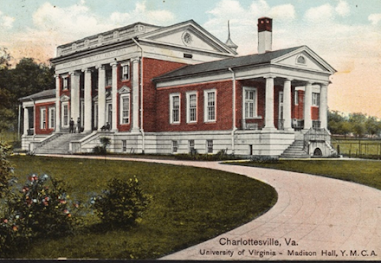
More perusing of the newspaper now known as TheCavalier Daily turned up a slew of ads for the Levy Opera House, the big,three-story Georgia-style brick building on the corner of Park and High Streetsin downtown Charlottesville dating from 1852, which Jefferson Levy bought in 1887. A gathering spot for local groups, travelingspeakers, and touring theatrical companies known as Town Hall, by the mid-1880sthe building had fallen into disrepair and disuse. The entrepreneurial Levyremodeled it and in 1888 renamed it the Levy Opera House.
In 1891 JeffersonLevy leased the Opera House to Jacob (“Jake”) Leterman and Ernest Oberdorfer,sons of the founders of Charlottesville’s German Reform synagogue, CongregationBeth Israel. Leterman and Oberdorfer brought in symphony orchestras, minstrelshows, and many other types of theatrical productions.
Here are two ads fromthe November 11, 1893, College Topics filled with details about two typical,late-nineteenth century productions: a road company version of thelong-running Broadway musical “The Black Crook,” a retelling of the Faust story;and a touring company’s comedic farce, “Niobe,” involving a marble statue ofthe Greek mythological figure brought to life after being hit by lightning, whichwould go to London and have a 500-plus performance run the following year on thecity’s West End.
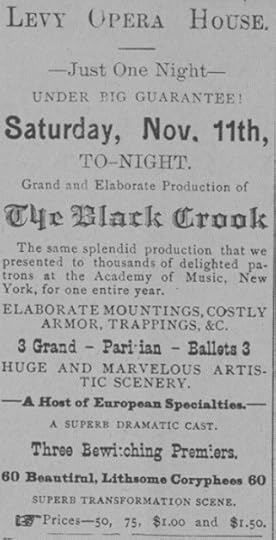
The Levy Opera House, whichclosed in 1912, later was converted into apartments. Then, in the early 1980s,it was used as office space. Today, as I recently learned from my friend and C’villenative Amoret Bruguiere, more changes are afoot at the Levy Opera House, whichmost recently had been used as overflow space for the nearby Albemarle Countycourts complex.
As we speak, the three-storybuilding, (in the 1960s photo, below), is being renovated and remodeledone more time. When completed in 2027, the Opera House will house the CountyCommonwealth Attorney’s offices as part of a new, $37-million jointCharlottesville-Albemarle County courts complex. The complex will include boththe City of Charlottesville’s and the County’s General District Courts andtheir offices.
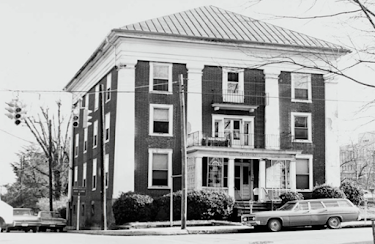
The Opera House will be preserved, and will be gettinga new roof to replace the current metal one. All of the exterior brickwork willbe restored, and much of the rear wall will be demolished and connected to anew multi-story annex building that will be part of the courts part of the complex(see mockup below).
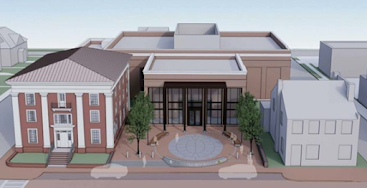
EVENTS: Subscribers may have noticed that this newsletter has arrived afew weeks later in the month than all the others. That’s because I spent thefirst half of March finishing my next book, a slice-of-life biography of U.S.Navy Seaman Apprentice Doug Hegdahl, the lowest-ranking and youngest Americancaptured in North Vietnam and held prisoner there during the Vietnam War.
The new pub date for the book—tentatively titled,The Unlikely War Hero—is December 17. You can get a sneak preview ofwhat the book is about at https://bit.ly/PrePubInfo
As for events, I have talks scheduled forApril and later in the year. For details, check the Events page on my website: marcleepson.com/events
THE ELEVENTH PRINTING: My friends at the University of Virginia Press tell me that thepaperback Saving Monticello, which the Press began publishing in 2003after the Simon & Schuster hardcover went out of print, will be going intoits eleventh printing. The paperback now is on backorder until physicalcopies come off the presses.
Inthe meantime, if you would like a new paperback of Saving Monticello, I have a few on hand.
To orderthat book, or the just-published hardcover of Huntland, go to this pageon my website https://bit.ly/BookOrdering or email me at marcleepson@gmail.com I also have a few used Saving Monticello hardcovers and a stack of five of my other books: Flag:An American Biography; Desperate Engagement; What So Proudly We Hailed; Flag: An American Biography; and Ballad of the Green Beret.




